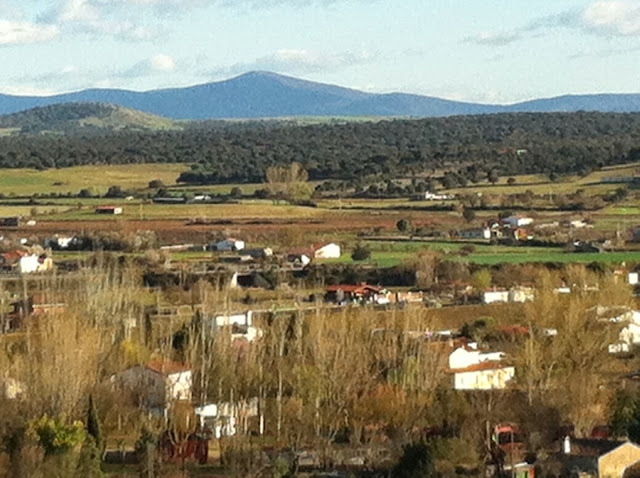This small walled town near the Portuguese border, built on a rocky outcrop on the banks of the river Agadon looked like an attractive place for an overnight stop from the description in Lonely Planet. When we arrived it was later in the afternoon than we had anticipated due to the shenanigans with the motorway toll. We were pleased to find the camp site open, for it was not listed in the ACSI book, just somewhere we had come across while browsing Google maps; its web-site seemed to say it was open all year, but our Spanish is minimal and we could not be sure. In some ways we have been unadventurous so far as places we've stayed in - keeping to the ACSI listed sites and stopping places in All the Aires book. Next time we might do a bit more on-line research and seek out places where you can wild camp, or stay in other unlisted Aires. It would bring the cost down, I think this half of the trip has been more expensive than in the Autumn, even if you discount unforeseen expenses like the €195 spent on the new battery.
Although the site gates were open, and eventually a man appeared from the bar and told us to choose a pitch and someone would open reception at six to sign us in, we were the only people staying, and clearly the place looked more or less closed However the hook-up functioned, the women's half of the toilet block was unlocked, and once I had worked out how to unlatch the heavy metal security gate on the washing-up room, it too became accessible, and there seemed to be hot water on tap. The place was a little old fashioned and down at heel, but functional, reminiscent French camping municipal. It was fun being the only people on site, it felt slightly off the beaten track and adventurous.
 |
| On our own |
The walled town on the hill seemed like about a 15 minute walk, the sun was trying to break through, so we decided to take a look. To get there we went through a small bario of working class housing - perhaps dating from the nineteenth century. When we crossed the narrow old bridge across the Agadon, I noticed a five storey abandoned mill building with a substantial race built downstream. Perhaps the area we had walked through once provided housing for its workers.
The town itself is much older than this, with medieval walls, an ancient castle, now converted into a swanky Parador, and old twisting streets and little squares lined with Renaissance period palacios. In many ways it looked like a smaller version of Caceres, it's more famous southerly neighbour. There is one in important difference however, though Caceres may have World Heritage status, its old city is a museum piece, empty and unused; Cuidad Rodrigo's citadel is still the town centre with shops, restaurants and cafés which as the afternoon moved towards evening were beginning to liven up. Gill even found an Orange shop to top-up the Moto.
 |
| The castle is one of the first Paradors, opening in 1932 |
 |
| These towns do have a distinctly Tuscan look |
 |
| The main square |
 |
| A modernista addition. |
We took a wall around the walls which have extensive views across the plain towards the mountains of Sierra de la Pena de Francia. After the colour of the south, even in the bright evening sunlight the scene had a forbidding wintry look. We spotted Maisy parked a kilometre or so distant among the camp-site's plane trees. Their pale bark and leafless branches looked bone-white as twilight gathered. Only the cherry blossom next to the Parador reminded you that Spring was on the way. I think it's probably a tardy visitor to the high plateaux of central Spain.
 |
| Ancient ramparts |
A clock tolled six. We headed back to the campsite to sign in. It's the sort of place where the most ordinary things provide momentary excitement, such as a flock of sheep clanging past the van, or the visit of a wagtail hopping close to filch our crumbs. It was very starry when I went out later with the washing-up. It would be a cold night.










No comments:
Post a Comment